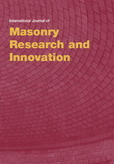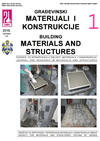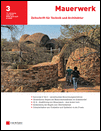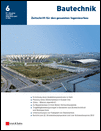
International Journal of Masonry Research and Innovation
Scope & Guideline
Innovating construction through cutting-edge research.
Introduction
Aims and Scopes
- Structural Assessment and Health Monitoring:
The journal places a significant emphasis on the structural assessment and health monitoring of masonry buildings and structures, utilizing advanced methodologies such as numerical simulations, non-destructive testing, and dynamic characterization. - Material Properties and Innovations:
Research articles often explore the physical, mechanical, and thermal properties of various masonry materials, including innovative composites and eco-friendly alternatives, contributing to sustainable construction practices. - Seismic Vulnerability and Retrofitting Techniques:
A core focus is on understanding the seismic behavior of masonry structures and developing retrofitting techniques to enhance their resilience against earthquakes, which is critical for preserving historical buildings. - Experimental and Numerical Methodologies:
The journal encourages the use of both experimental investigations and numerical modeling approaches to provide comprehensive insights into masonry behavior under various loading conditions. - Historical Masonry Preservation:
There is a strong commitment to the preservation and restoration of historical masonry structures, including studies that assess the impact of environmental factors and structural interventions on heritage buildings.
Trending and Emerging
- Sustainable Materials and Eco-Friendly Practices:
There is a noticeable increase in research focused on sustainable masonry materials, including the use of recycled or waste materials, which aligns with global efforts towards environmental conservation and energy efficiency in construction. - Advanced Structural Health Monitoring Techniques:
The use of sophisticated structural health monitoring techniques, including IoT-based systems and non-destructive testing methods, is gaining traction, enabling real-time assessment of masonry structures. - Integration of Digital Tools in Masonry Analysis:
Emerging trends include the integration of digital tools such as finite element modeling and computational simulations, facilitating more accurate predictions of masonry behavior and enhancing design methodologies. - Retrofitting Innovations for Historical Structures:
There is an increasing focus on innovative retrofitting methods specifically designed for historical masonry structures, incorporating modern materials and techniques to improve seismic resilience without compromising heritage value. - Multidisciplinary Approaches to Masonry Research:
Research is increasingly adopting multidisciplinary approaches, combining insights from engineering, architecture, and materials science to address complex challenges in masonry design and preservation.
Declining or Waning
- Traditional Masonry Techniques:
Research focusing on traditional masonry techniques and historical construction methods appears to be decreasing, as there is a growing preference for modern materials and methodologies that prioritize innovation and efficiency. - Basic Mechanical Testing:
The frequency of studies concentrating solely on basic mechanical testing of masonry materials has waned, with a shift towards more complex analyses that integrate advanced modeling and multi-faceted experimental approaches. - General Reviews on Masonry Literature:
Comprehensive reviews summarizing existing literature on masonry have become less common, as the journal leans towards publishing original research that contributes new knowledge rather than reviews of past work.
Similar Journals

Journal of Materials and Engineering Structures
Exploring Cutting-Edge Research in Engineering StructuresJournal of Materials and Engineering Structures is a pioneering Open Access journal published by MOULOUD MAMMERI UNIVERSITY OF TIZI-OUZOU, dedicated to advancing the field of materials science and engineering. Since its inception in 2014, the journal has aimed to provide researchers, professionals, and students with a platform for sharing cutting-edge research and innovative applications in materials engineering and construction structures. Although the HIndex and Scopus ranking data are not specified, the journal plays a crucial role in disseminating knowledge that contributes to the development of sustainable and efficient engineering practices. With its commitment to accessibility and knowledge sharing in the heart of Algeria, the Journal of Materials and Engineering Structures is poised to make a significant impact on both local and global academic communities.

JOURNAL OF STRUCTURAL ENGINEERING
Pioneering Research in Structural IntegrityThe JOURNAL OF STRUCTURAL ENGINEERING, published by the ASCE-AMERICAN SOCIETY OF CIVIL ENGINEERS, is a premier academic journal that focuses on the latest advancements in the field of structural engineering. With a rich history dating back to 1955, this journal has become a crucial platform for disseminating peer-reviewed research that addresses critical issues and innovative solutions in building and construction, civil and structural engineering, materials science, and mechanics. It proudly holds a Q1 quartile ranking across multiple categories in the 2023 Scopus rankings, indicating its influential presence in the academic community. The journal does not currently offer open access options, ensuring that the content is rigorously vetted for quality and relevance, thus appealing to researchers, industry professionals, and students seeking credible, impactful research. With contributions from leading experts, the JOURNAL OF STRUCTURAL ENGINEERING is essential reading for anyone interested in advancing their understanding and practice within this vital area of engineering.

Gradevnski Materijiali I Konstrukcije-Building Materials and Structures
Transforming ideas into impactful solutions for the built environment.Gradevnski Materijiali I Konstrukcije - Building Materials and Structures is a premier open-access journal dedicated to advancing the field of construction materials and structural engineering. Published by SOC MATERIALS & STRUCTURES TESTING SERBIA, this journal provides a platform for researchers, professionals, and students to share their innovative findings and developments in building materials. With a commitment to open-access since 2012, it fosters unrestricted availability of research for a wider audience, encouraging collaboration and knowledge dissemination. The journal features a diverse range of topics, including material testing, structural integrity, and sustainable construction practices, making it a vital resource for those engaged in the design and analysis of structural components. By fostering the advancement of research and practice in this crucial sector, Gradevnski Materijiali I Konstrukcije plays an essential role in shaping the future of construction and material science.

Journal of Structural Integrity and Maintenance
Exploring Cutting-edge Research in Structural IntegrityThe Journal of Structural Integrity and Maintenance, published by Taylor & Francis Ltd, serves as a prestigious platform dedicated to the advancement of knowledge in the fields of structural integrity, civil engineering, and materials science. With an ISSN of 2470-5314 and an E-ISSN of 2470-5322, this journal is uniquely positioned to address the critical challenges faced by researchers and professionals in building and construction, mechanical engineering, and related domains. Since its inception in 2016, this journal has been consistently recognized for its quality, currently holding a Q2 rank across several disciplines, including Building and Construction and Civil and Structural Engineering in 2023. The journal aims to publish high-quality research that contributes to the understanding and maintenance of structural integrity, fostering innovations that promote safety, efficiency, and sustainability in engineering practices. Researchers and students alike are encouraged to engage with this rich repository of knowledge, which plays a vital role in shaping future advancements in structural engineering and materials science.

Stahlbau
Bridging Disciplines: Where Engineering Meets Innovation.Stahlbau is a prestigious journal published by ERNST & SOHN, focusing on the intersection of materials science, civil engineering, and mechanical engineering. With its roots dating back to 1968 and extensive coverage through 2024, this journal serves as a vital platform for the dissemination of innovative research and insights in the fields of Building and Construction, Civil and Structural Engineering, and Advances in Metals and Alloys. Despite its categorization in the Q3 quartile across several disciplines, it is recognized for its rigorous peer-reviewed articles and its commitment to advancing knowledge in structural engineering and materials' performance. The journal aims to foster a dynamic dialogue among researchers, industry professionals, and students, making it an essential resource for anyone looking to stay at the forefront of developments in construction and materials engineering. Access options reflect a commitment to intellectual exchange in academia, emphasizing the journal's role as a cornerstone for emerging research and best practices.

Revista Ingenieria de Construccion
Pioneering Insights in Building and Construction EngineeringRevista Ingenieria de Construccion is a prominent open-access journal dedicated to advancing knowledge and practice in the fields of building and construction engineering, as well as civil and structural engineering. Published by the Pontificia Universidad Católica de Chile, specifically the Department of Engineering and Construction Management, this journal has been providing free access to quality research outputs since 1986, ensuring that vital information is available to both practitioners and academics globally. With its current placement in the Q4 category of both the Building and Construction and Civil and Structural Engineering quartiles, it serves as a platform for innovative studies and critical discussions, positioning itself strategically within the academic landscape. The journal is indexed in Scopus, ranking #157 in Building and Construction and #291 in Civil and Structural Engineering, reflecting the growing impact and relevance of its contributions. Researchers, professionals, and students are encouraged to engage with the rigorous and diverse content published within its pages, fostering a vibrant academic and practical discourse.

Mauerwerk
Advancing masonry knowledge for a stronger future.Mauerwerk is a distinguished journal dedicated to the field of masonry and related construction technologies, published by ERNST & SOHN. With its ISSN 1432-3427 and E-ISSN 1437-1022, this journal takes pride in disseminating peer-reviewed research aimed at advancing the knowledge and practice of masonry disciplines. Although it does not operate under an open access model, the journal provides critical insights into innovative practices, material advancements, and engineering techniques pivotal to the construction industry. Hailing from Berlin, Germany, Mauerwerk offers a platform for researchers, professionals, and students to share their findings, collaborate, and keep abreast of the latest developments in the field. The journal not only enhances academic discourse but also serves as an essential resource for practitioners aiming to apply research outcomes to real-world challenges.

Bautechnik
Exploring the forefront of building technology and methodologies.Bautechnik is a premier academic journal in the fields of Building and Construction and Civil and Structural Engineering, published by ERNST & SOHN in Germany. With a history dating back to 1969 and a significant converged timeline through various years, this journal offers a rich repository of peer-reviewed research dedicated to advancing the principles, methodologies, and innovations within its domains. Bautechnik is currently ranked in the Q3 category for both building and construction, as well as civil and structural engineering, indicating its relevance and contribution to the academic community. Though it does not offer open access, its curated content is accessible to a global audience of researchers, professionals, and students striving for excellence in their fields. The journal aims to foster discussions and disseminate knowledge that impacts the future of construction, architecture, and engineering practices.

Journal of Bridge Engineering
Connecting Ideas, Building BridgesThe Journal of Bridge Engineering, published by the ASCE - American Society of Civil Engineers, is a premier academic journal dedicated to the specialized field of bridge engineering and structural design. With a strong commitment to advancing knowledge from 1996 to 2024, this journal is recognized for its excellence, holding a prestigious Q1 ranking in both the Building and Construction and Civil and Structural Engineering categories according to the latest 2023 metrics. The journal's ISSN 1084-0702 and E-ISSN 1943-5592 signify its commitment to scholarly communication in a digital age. While it does not currently follow an open access model, the Journal of Bridge Engineering significantly impacts the engineering community, appealing to researchers, professionals, and students who seek cutting-edge research and innovative practices in bridge engineering. Its current rankings on Scopus place it among the top journals in its field, reinforcing its role as a critical resource for advancing the state of the art in bridge design, maintenance, and sustainability.

Ingegneria Sismica
Exploring the forefront of earthquake engineering.Ingegneria Sismica, a premier journal published by PATRON EDITORE S R L, serves as an essential platform for the dissemination of research in the fields of building and construction, geotechnical engineering, and safety risk management. With a focus on earthquake engineering and structural safety, the journal has established itself as a prominent source of knowledge since its inception in 2010. The journal holds an impressive Q2 classification in multiple categories, including Building and Construction and Geotechnical Engineering, reflecting its significant impact within these disciplines. Despite its Italian roots, it appeals to an international audience of researchers, professionals, and students dedicated to advancing the understanding of seismic resilience and risk mitigation strategies. Although open access is not currently available, the potential for knowledge sharing and innovative methodologies presented in the articles continues to attract a robust readership. With its commitment to excellence and relevance, Ingegneria Sismica is poised to shape future discourse in engineering practices aimed at enhancing safety, reliability, and quality within seismic zones.